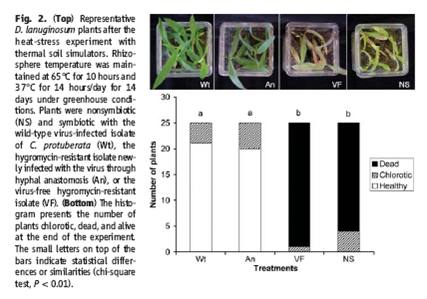Here’s a really interesting story that I picked up on while reading ERV’s blog. We hear about 2-way symbioses/mutualisms (fungus+alga & fungus+cyanobacterium in lichens, & the mycorrhizal relationship between plants & fungi) – but here’s something special: a three-way symbiosis between a fungus, a grass – & a virus (Marquez et al., 2008).
The fungus (Curvularia protuberata) is an endophyte – a fungus that grows within the plant’s tissues. Endophytes are known to aid plants in living in extreme environments. The plant in question is a ‘panic grass’ (Dichanthelium lanuginosum) that grows on geothermal soils. Together, these organisms are able to grow in soil temperatures of up to 65oC. Separated, they are restricted to temperatures of 38oC or less. Subject to heat stress, panic grass plants without their fungal symbiont either die, or survive but shrivel & lose their green colour – & when there’s no heat stress the plants are both drought-tolerant & more vigorous than plants without their symbiont.
Marquez et al. (2008) comment that it’s known that fungal viruses (mycoviruses) can affect plant-fungus relationships, but theirs was the first study to look specifically at this in endophytes. It was relatively easy to look for the presence of a virus, because mycoviruses generally carry their genes on double-stranded RNA (dsRNA). These are normally absent in fungal cells, so the presence of dsRNA in a fungus suggests the presence of a virus, & this is what the team found in C. protuberata. They also managed to purify virus particles from the fungus.
It turned out the fungus has to be infected by the virus (called CThTV for Curvularia thermal tolerance virus) if the fungus-plant symbiosis is to survive high temperatures. The team tested this experimentally. They obtained wild-type (with high concentrations of viral particles) & virus-free fungus and used them to inoculate panic grass plants. Then the plants were exposed to a range of different soil temperatures. The result: Plants inoculated with the virus-infected wild-type isolate of the fungus tolerated intermittent soil temperatures as high as 65oC for 2 weeks…, whereas both nonsymbiotic plants and plants inoculated with the virus-free isolate of the fungus became shriveled and chlorotic and died.
Was this really due to the virus? Marquez & his co-workers tested this by infecting their virus-free fungus with CThTV & using this combination to inoculate another batch of plants. Bingo! [The] isolate newly infected with CThTV confers the same level of heat tolerance as that conferred by the wild-type isolate.
I’ve said it before – I learn something new every day 🙂

Image from Marquez et al. (2008)
L.M. Marquez, R.S. Redman, R.J. Rodriguez & M.J. Roossinck (2008) A virus in a fungus in a plant: three-way symbiosis required for thermal tolerance. Science 315: 513-515, doi 10.1126/science.1136237
Heraclides says:
You might want to fix the link to ERV’s article! (erv in lowercase, followed by a slash.) For those in a hurry, this looks like the article: http://scienceblogs.com/erv/2008/10/erv_cancer_virus.php
When I have time I hope to read them: they look good articles.
Alison Campbell says:
Dratted hyperlinks! Thank you, ’tis done 🙂 (I hope!) I enjoy ERV’s writing, even if sometimes the lack of apostrophes annoys me 🙂
Heraclides says:
All that marking is making you a grammar Nazi, eh?! 😉
Alison Campbell says:
Taking Latin for 3 years at high school did that for me!